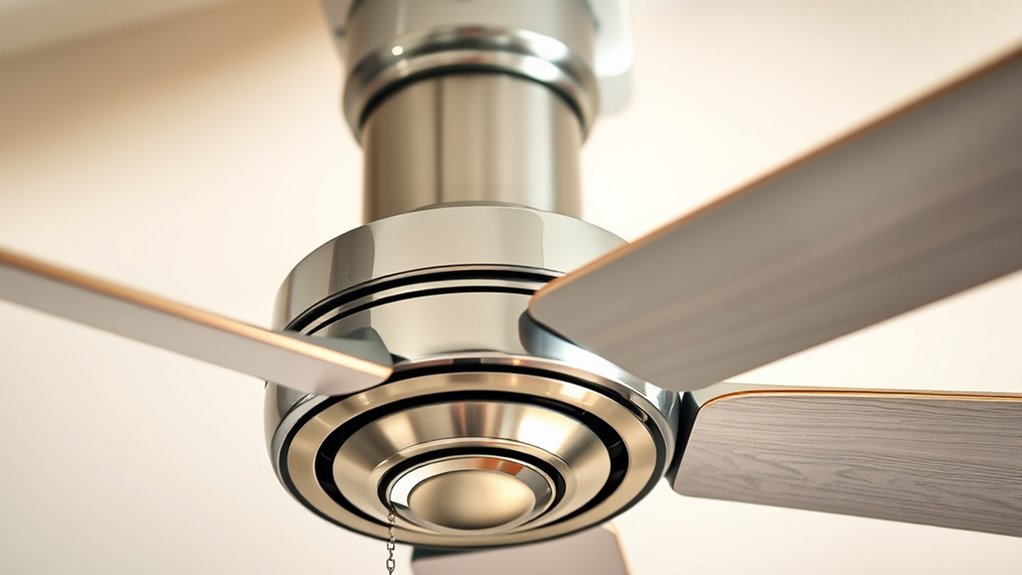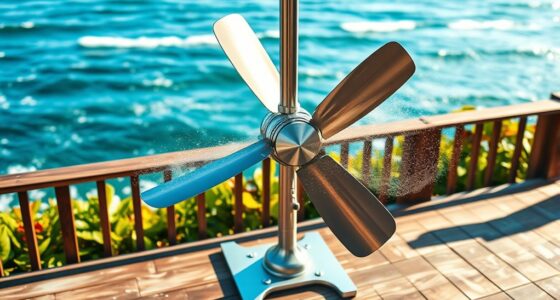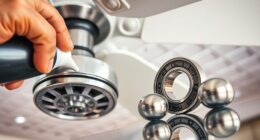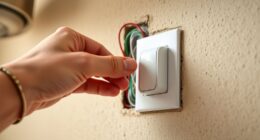To prevent accidents and injuries with ceiling fans, guarantee proper installation by following manufacturer instructions and local electrical codes, hiring a licensed electrician if needed. Regularly inspect and maintain the blades, mounting hardware, and wiring for wear, damage, or imbalance. Always turn off power before cleaning or repairs and avoid overloading the fan. Address irregularities promptly to maintain safe operation. For thorough safety strategies, continue exploring essential tips to keep your ceiling fan secure and hazard-free.
Key Takeaways
- Ensure proper installation by securing mounting brackets and following electrical codes, preferably hiring a licensed electrician.
- Regularly inspect and clean blades and hardware to prevent wobbling, loosening, or damage.
- Turn off power before maintenance or cleaning, and avoid working on energized fans to prevent electric shocks.
- Use fans within their size and weight limits, avoiding overloads or attaching unsafe decorations.
- Address any unusual noises, vibrations, or damage immediately to prevent accidents or injuries.

Have you considered the critical importance of ceiling fan safety in your home? Ensuring your ceiling fan operates safely is fundamental to prevent accidents, injuries, and property damage. Proper installation, maintenance, and usage are essential components that safeguard everyone in your household. First, verify that your ceiling fan is installed according to the manufacturer’s specifications and local electrical codes. A faulty or improper installation can lead to mechanical failure or electrical hazards, such as short circuits or fires. Use a sturdy ceiling support that can handle the fan’s weight, and ensure all mounting brackets are securely fastened. Confirm that the electrical connections are correctly wired, with grounding properly established to prevent electric shock. If you lack experience with electrical work, hire a licensed electrician to perform or verify the installation.
Regular maintenance is crucial for ongoing safety. Periodically inspect the fan blades for signs of wear, warping, or imbalance. Damaged or loose blades can generate excessive vibration, resulting in noise and potential structural damage. Balance the blades using manufacturer-approved tools and procedures to minimize wobble. Check that all screws, nuts, and bolts are tight, especially around the mounting hardware and blade brackets. Over time, hardware can loosen due to vibration, increasing the risk of detachment. Clean the fan blades and motor housing carefully, avoiding moisture or harsh chemicals that could cause corrosion or electrical shorts. Lubricate moving parts as recommended by the manufacturer to ensure smooth operation and reduce strain on the motor. Additionally, inspect the electrical wiring periodically for signs of fraying, corrosion, or other damage, and replace compromised components immediately. Understanding gelato quality can also be helpful when considering the safety of appliances that involve temperature regulation.
Operational safety requires adherence to usage guidelines. Always use the appropriate size and weight capacity for your fan, and avoid overloading the fan with excessive decorative items or attachments. Use a safety chain or cord restraint if your fan is in a high-traffic area to prevent accidental contact or pulling. Ensure that the fan’s pull chains or control switches are functioning correctly and are not obstructed. When cleaning or performing maintenance, turn off the power at the circuit breaker and wait for the blades to come to a complete stop before proceeding. Never attempt repairs on a fan that is still energized, as this increases the risk of electric shock or injury. If you notice unusual noises, excessive vibrations, or other irregularities, turn off the fan immediately and seek professional assistance. Maintaining a safety-conscious approach at each stage of your ceiling fan’s lifecycle is essential for preventing accidents and ensuring a secure environment for everyone in your home.
Frequently Asked Questions
How Often Should Ceiling Fans Be Inspected for Safety?
You should inspect your ceiling fan at least once every six months to guarantee safety. During these inspections, check for loose blades, secure mounting, and electrical connections. Look for signs of wear or corrosion, and listen for unusual noises during operation. Regular maintenance helps prevent accidents and injuries by catching potential issues early. Always turn off the power before inspecting or performing any repairs to avoid electrical hazards.
Can Ceiling Fans Cause Electrical Fires if Not Properly Maintained?
Yes, ceiling fans can cause electrical fires if not properly maintained. Over time, dust buildup, loose wiring, or damaged components can lead to electrical shorts or overheating. You should regularly inspect your fan for signs of wear, tighten connections, and replace any frayed wires. Ensuring proper installation and routine maintenance considerably reduces fire risk, protecting both your property and personal safety.
What Safety Precautions Should Children Take Around Ceiling Fans?
Like cautious sailors steering treacherous waters, children should keep a safe distance from ceiling fans, avoiding the blades’ whirlpools of motion. They must never reach up or attempt to touch the moving blades, especially when the fan is on. Supervising adults should make sure fan blades are securely fastened, and pull cords are out of children’s reach. Educate children about the dangers to prevent accidents, fostering a culture of safety around ceiling fans.
Are There Specific Ceiling Fan Models With Enhanced Safety Features?
Yes, some ceiling fan models feature enhanced safety features such as blade guards, child-proof switches, and retractable blades to minimize injury risk. Look for fans with enclosed blades or safety grills, especially for homes with children. Confirm the fan has a stable mounting system and auto shut-off functions. Always follow manufacturer instructions for installation and maintenance to maximize safety. Choosing models with these features reduces potential accidents effectively.
How Do I Safely Replace a Ceiling Fan’s Blades or Parts?
Imagine carefully unwrapping a delicate butterfly from its cocoon. To safely replace your ceiling fan’s blades or parts, turn off the power at the circuit breaker, verify with a tester that the circuit’s dead, and use a sturdy ladder. Remove screws gently, supporting blades with your hand as you detach them. Install new parts securely, ensuring all screws are tight, then restore power and test the fan’s balance for safe operation.
Conclusion
By adhering to proper installation and maintenance procedures, you minimize the risk of ceiling fan accidents. Yet, overlooking safety protocols can turn a simple comfort device into a hazard, causing injuries or property damage. Vigilance in inspection and timely repairs guarantees safety remains a priority. Remember, precision and caution are your best defenses—balancing efficiency with safety to prevent preventable accidents while enjoying the benefits of your ceiling fan.









